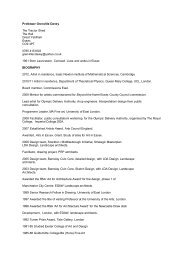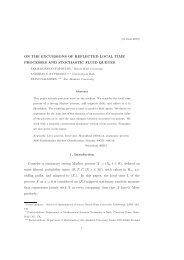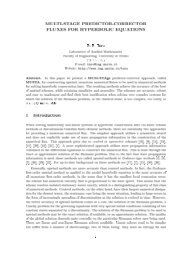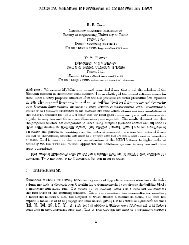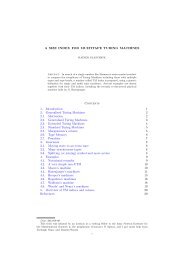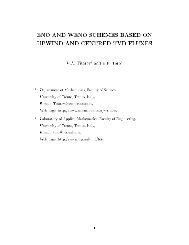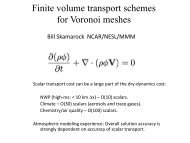Optimal Designs for the Prediction of Individual Effects in Random ...
Optimal Designs for the Prediction of Individual Effects in Random ...
Optimal Designs for the Prediction of Individual Effects in Random ...
Create successful ePaper yourself
Turn your PDF publications into a flip-book with our unique Google optimized e-Paper software.
6 Maryna Prus and Ra<strong>in</strong>er Schwabe<br />
covariance matrix D = diag(d1,d2) <strong>of</strong> <strong>the</strong> random effects is diagonal with diagonal<br />
entries d1 and d2 <strong>for</strong> <strong>the</strong> variance <strong>of</strong> <strong>the</strong> <strong>in</strong>tercept and <strong>the</strong> slope, respectively. To<br />
exhibit <strong>the</strong> differences <strong>in</strong> <strong>the</strong> design criteria <strong>the</strong> variance <strong>of</strong> <strong>the</strong> <strong>in</strong>tercept is assumed<br />
to be small, d1 < 1/m.<br />
Accord<strong>in</strong>g to Theorems 1 and 2, <strong>the</strong> IMSE-optimal designs only take observations<br />
at <strong>the</strong> endpo<strong>in</strong>ts x = 0 and x = 1 <strong>of</strong> <strong>the</strong> design region, as <strong>the</strong> sensitivity functions,<br />
which are <strong>the</strong> left hand sides <strong>in</strong> <strong>the</strong> conditions (13) and (16), are polynomials<br />
<strong>in</strong> x <strong>of</strong> degree 2. Hence, <strong>the</strong> optimal design ξ ∗ is <strong>of</strong> <strong>the</strong> <strong>for</strong>m<br />
� �<br />
0 1<br />
ξw =<br />
, (17)<br />
1 − w w<br />
and only <strong>the</strong> optimal weight w ∗ has to be determ<strong>in</strong>ed. For designs ξw <strong>the</strong> criterion<br />
functions (12) and (15) are calculated with δk = mdk to<br />
Φ β (ξw) = 1 3<br />
Φb(ξw) = 1 3<br />
�<br />
(n−1)(3δ1+δ2+δ1δ2)<br />
(δ1+1)(wδ2+1)−w2 1 +<br />
δ1δ2 w(1−w)<br />
�<br />
(n−1)(3δ1+δ2+δ1δ2)<br />
(δ1+1)(wδ2+1)−w2δ1δ2 + 3δ1 + δ2<br />
�<br />
, (18)<br />
�<br />
. (19)<br />
To obta<strong>in</strong> numerical results <strong>the</strong> number <strong>of</strong> <strong>in</strong>dividuals and <strong>the</strong> number <strong>of</strong> observations<br />
at each <strong>in</strong>dividual are fixed to n = 100 and m = 10. For <strong>the</strong> variance d1 <strong>of</strong> <strong>the</strong><br />
<strong>in</strong>tercept we use <strong>the</strong> value 0.001. Figure 1 illustrates <strong>the</strong> dependence <strong>of</strong> <strong>the</strong> optimal<br />
weight w∗ and <strong>the</strong> rescaled variance parameter ρ = d2/(1 + d2), which mimics <strong>in</strong><br />
a way <strong>the</strong> <strong>in</strong>traclass correlation and has <strong>the</strong> advantage to be bounded such that <strong>the</strong><br />
whole range <strong>of</strong> slope variances d2 can be shown. The optimal weight <strong>for</strong> <strong>the</strong> prediction<br />
<strong>of</strong> <strong>in</strong>dividual parameters <strong>in</strong>creases <strong>in</strong> <strong>the</strong> slope variance d2 from 0.5 <strong>for</strong> d2 → 0<br />
to about 0.91 <strong>for</strong> d2 → ∞. For d1 < 1/m <strong>the</strong> Bayesian optimal design, which is also<br />
optimal <strong>for</strong> <strong>the</strong> prediction <strong>of</strong> <strong>in</strong>dividual deviations, has optimal weight w∗ = 1 <strong>for</strong><br />
all positive values <strong>of</strong> d2, which results <strong>in</strong> a s<strong>in</strong>gular design.<br />
In Figure 2 <strong>the</strong> efficiencies eff(ξ ) = Φ(ξw∗)/Φ(ξ ) are plotted <strong>for</strong> <strong>the</strong> optimal<br />
design ξ0.5 <strong>in</strong> <strong>the</strong> fixed effects model ignor<strong>in</strong>g <strong>the</strong> <strong>in</strong>dividual effects and<br />
<strong>for</strong> <strong>the</strong> naive equidistant design ¯ ξ , which assigns weights 1/m to <strong>the</strong> m sett<strong>in</strong>gs<br />
x j = ( j − 1)/(m − 1). For <strong>the</strong> prediction <strong>of</strong> <strong>in</strong>dividual parameters <strong>the</strong> efficiency <strong>of</strong><br />
<strong>the</strong> design ξ0.5 decreases from 1 <strong>for</strong> d2 → 0 to approximately 0.60 <strong>for</strong> d2 → ∞,<br />
whereas ¯ ξ shows an overall lower per<strong>for</strong>mance go<strong>in</strong>g down to 0.42 <strong>for</strong> large d2.<br />
For <strong>the</strong> prediction <strong>of</strong> <strong>in</strong>dividual deviations <strong>the</strong> efficiency <strong>of</strong> both designs show a<br />
bathtub shaped behavior with limit<strong>in</strong>g efficiency <strong>of</strong> 1 <strong>for</strong> d2 → 0 or d2 → ∞. This<br />
is due to <strong>the</strong> fact that all regular designs are equally good <strong>for</strong> small d2 and equally<br />
bad <strong>for</strong> large d2, s<strong>in</strong>ce <strong>the</strong> criterion function (15) behaves like tr(∆V) <strong>for</strong> d2 → ∞<br />
<strong>in</strong>dependently <strong>of</strong> ξ . The m<strong>in</strong>imal efficiencies are 0.57 <strong>for</strong> ξ0.5 and 0.43 <strong>for</strong> ¯ ξ .<br />
For <strong>the</strong> sake <strong>of</strong> completeness also <strong>the</strong> efficiency is plotted with respect to <strong>the</strong><br />
Bayes criterion, which equals <strong>the</strong> first term <strong>in</strong> both criteria (12) and (15) to show<br />
that <strong>the</strong> efficiency may differ although <strong>the</strong> design optimization seems to be <strong>the</strong> same.<br />
This difference is due to <strong>the</strong> second (constant) term <strong>in</strong> (15). It should also be noted




